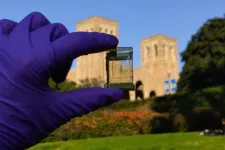(Press-News.org) Scientists have long wondered how the eye’s three cone photoreceptor types work together to allow humans to perceive color. In a new study in the Journal of Neuroscience, researchers at the University of Rochester used adaptive optics to identify rare retinal ganglion cells (RGCs) that could help fill in the gaps in existing theories of color perception.
The retina has three types of cones to detect color that are sensitive to either short, medium, or long wavelengths of light. Retinal ganglion cells transmit input from these cones to the central nervous system.
In the 1980s, David Williams, the William G. Allyn Professor of Medical Optics, helped map the “cardinal directions” that explain color detection. However, there are differences in the way the eye detects color and how color appears to humans. Scientists suspected that while most RGCs follow the cardinal directions, they may work in tandem with small numbers of non-cardinal RGCs to create more complex perceptions.
Recently, a team of researchers from Rochester’s Center for Visual Science, the Institute of Optics, and the Flaum Eye Institute identified some of these elusive non-cardinal RGCs in the fovea that could explain how humans see red, green, blue, and yellow.
“We don’t really know anything for certain yet about these cells other than that they exist,” says Sara Patterson, a postdoctoral researcher at the Center for Visual Science who led the study. “There’s so much more that we have to learn about how their response properties operate, but they’re a compelling option as a missing link in how our retina processes color.”
Using adaptive optics to overcome light distortion in the eye
The team leveraged adaptive optics, which uses a deformable mirror to overcome light distortion and was first developed by astronomers to reduce image blur in ground-based telescopes. In the 1990s, Williams and his colleagues began applying adaptive optics to study the human eye. They created a camera that compensated for distortions caused by the eye’s natural aberrations, producing a clear image of individual photoreceptor cells.
“The optics of the eye’s lens are imperfect and really reduce the amount of resolution you can get with an ophthalmoscope,” says Patterson. “Adaptive optics detects and corrects for these aberrations and gives us a crystal-clear look into the eye. This gives us unprecedented access to the retinal ganglion cells, which are the sole source of visual information to the brain.”
Patterson says improving our understanding of the retina’s complex processes could ultimately help lead to better methods for restoring vision for people who have lost it.
“Humans have more than 20 ganglion cells and our models of human vision are only based on three,” says Patterson. “There’s so much going on in the retina that we don’t know about. This is one of the rare areas where engineering has totally outpaced visual basic science. People are out there with retinal prosthetics in their eyes right now, but if we knew what all those cells do, we could actually have retinal prosthetics drive ganglion cells in accordance with their actual functional roles.”
The work was supported through funding by the National Institutes of Health, Air Force Office of Scientific Research, and Research to Prevent Blindness.
END
Are these newly found rare cells a missing link in color perception?
Rochester researchers harnessed adaptive optics to gain insight into the complex workings of the retina and its role in processing color
2024-04-15
ELSE PRESS RELEASES FROM THIS DATE:
Annals supplement highlights important new evidence readers ‘may have missed’ in 2023
2024-04-15
Embargoed for release until 5:00 p.m. ET on Monday 15 April 2024
Annals of Internal Medicine Tip Sheet
@Annalsofim
Below please find summaries of new articles that will be published in the next issue of Annals of Internal Medicine. The summaries are not intended to substitute for the full articles as a source of information. This information is under strict embargo and by taking it into possession, media representatives are committing to the terms of the embargo not only on their own behalf, but also on behalf ...
NIH awards $2.3 million grant to University of Oklahoma for gene therapy research
2024-04-15
NORMAN, OKLA. – University of Oklahoma engineering researcher Sangpil Yoon, Ph.D., has been awarded a $2.3 million grant from the U.S. Department of Health and Human Services, National Institutes of Health, for his project titled “Development of protein-based nanostructures activated by ultrasound.”
The five-year grant is part of the NIH’s Research Project Grant (R01) program, which supports cutting-edge health-related research and development initiatives. Yoon’s funding, totaling $363,919 for ...
Hidden threat: Global underground infrastructure vulnerable to sea-level rise
2024-04-15
As sea levels rise, coastal groundwater is lifted closer to the ground surface while also becoming saltier and more corrosive. A recent study by earth scientists at the University of Hawai‘i (UH) at Mānoa compiled research from experts worldwide showing that in cities where there are complex networks of buried and partially buried infrastructure, interaction with this shallower and saltier groundwater exacerbates corrosion and failure of critical systems such as sewer lines, roadways, and building foundations.
“While it has been recognized that shallowing groundwater will eventually result in chronic flooding as it surfaces, ...
Study reveals AI enhances physician-patient communication
2024-04-15
As one of the first health systems in the country to pilot the use of generative artificial intelligence (GenAI) to draft replies to patient messages inside the Epic Systems electronic health record, UC San Diego Health is a pioneer in shaping the future of digital health.
The results of a new University of California San Diego School of Medicine study indicate that, although AI-generated replies did not reduce physician response time, they have contributed to relieving cognitive burden by starting an empathetic draft, which physicians can edit rather than starting from scratch.
The study, published in the April 15, 2024 online edition of the Journal of ...
Mitchell A. Lazar honored with prestigious George M. Kober Medal for pioneering contributions to diabetes and metabolic research
2024-04-15
PHILADELPHIA— Mitchell A. Lazar, M.D., Ph.D., the Rhoda and Willard Ware Professor in Diabetes and Metabolic Disease, and Director of the Institute for Diabetes, Obesity, and Metabolism in the Perelman School of Medicine at the University of Pennsylvania, is the 2025 recipient of the George M. Kober Medal from the Association of American Physicians (AAP). Lazar will receive the honor in Chicago at the AAP’s annual meeting which takes place April 25-27, 2025.
The AAP, an elected society of the nation’s most distinguished physician scientists, was founded in 1885 by seven physicians, including Sir William ...
SMU prof to use NSF grant to develop game-based semiconductor curriculum for high school students
2024-04-15
DALLAS (SMU) – The challenge is to connect the dots for high school students between the technology in their cell phones and the career options manufacturing the devices. To that end, the National Science Foundation (NSF) has awarded an Innovative Technology Experiences for Students and Teachers (ITEST) grant to SMU professor Lin Lipsmeyer and colleagues toward developing one of the first game-based semiconductor curricula for high school students.
The online game-based semiconductor curriculum will be made available to a wide range of students through a collaboration with Dallas-based gaming company Stimuli. Additional ...
Advance in light-based computing shows capabilities for future smart cameras
2024-04-15
Researchers developing the next generation of computing technology aim to bring some light to the field — literally.
Optical computing, which relies on particles of light called photons, is expected to provide alternatives to traditional electronic approaches. Such systems — or light-based components of hybrid systems that also retain electronic parts — could be faster, consume less energy and compute visual information more efficiently through simultaneous, parallel processing.
To date, ...
Q&A: How claims of anti-Christian bias can serve as racial dog whistles
2024-04-15
In a speech to a group of religious broadcasters in February, Donald Trump promised to create a task force to counter “anti-Christian bias,” which he said would investigate the “discrimination, harassment and persecution against Christians in America.”
It’s not the first time Trump has claimed that Christians are being persecuted, and he’s not alone. As more politicians repeat these statements, researchers from the University of Washington investigated whether anti-Christian bias claims can also be ...
Three advances in pavement technology — for safer, more sustainable roadways
2024-04-15
While April showers bring May flowers, these months also kick off road construction season — when cracks and potholes that developed over the winter get fixed. But recent advances could make future roadways safer and repairs more sustainable, thanks to smart pothole monitoring, snail shells and graphene. The new approaches can be found in three papers recently published in ACS journals. Reporters can request free access to these papers by emailing newsroom@acs.org.
A smart pothole monitoring system for cars. By harnessing the vibrations that shake a vehicle as it drives over uneven pavement, researchers have created a system that ...
Civil engineer looks to remedy inequities in traffic safety
2024-04-15
Alyssa Ryan, an assistant professor of civil and architectural engineering and mechanics, in the University of Arizona College of Engineering, is leading a national study to identify disparities in traffic safety for all transportation users, including drivers, bicyclists and walkers.
"Transportation engineering is very focused on people and impacting society and how people interact with the world," said Ryan. "If you don't have transportation, you can't do anything."
With a $467,000 ...
LAST 30 PRESS RELEASES:
Your pet's flea treatment could be destroying the planet
Diabetes risk not associated with timing or type of menopause
Bulk inorganic crystals grown from water emit “handed” light
A new AI-based attack framework advances multi-agent reinforcement learning by amplifying vulnerability and bypassing defenses
While exploring the cosmos, astronauts also fuel explorations of the biology of aging and cellular resilience
Design and synthesis of Zr-IR825 nanoparticles for photothermal therapy of tumor cells
Food critics or food grabbers? When choosing food, wood mice split into careful examiners who sniff and handle, and quick nut grabbers
‘Cosmic clock’ reveals Australian landscapes’ history and potential future
Higher maternal blood pressure increases the risk of pregnancy complications, study concludes
Postoperative complications of medical tourism may cost NHS up to £20,000/patient
Phone apps nearly 3 times as good as no/basic support for quitting smoking long term
Female sex and higher education linked to escalating prevalence of obesity and overweight in Africa
THE LANCET + eCLINICALMEDICINE: Two studies on reductions in mortality from small changes lifestyle changes
AI model identifies how every country can improve its cancer outcomes
Young people risk drifting into serious online offenses through a slippery slope of high-risk digital behavior
Implant provides lasting relief for treatment-resistant depression
Autologous T cell therapy targeting multiple antigens shows promise treating pancreatic cancer
First extensive study into marsupial gut microbiomes reveals new microbial species and antimicrobial resistance
Study debunks myth of native Hawaiians causing bird extinctions
Tailored biochar could transform how crops grow, resist disease, and clean polluted soils
Biochar-based enzyme technology offers new path for cleaner water and soil
Biochar helps farmland soils withstand extreme rain and drought by steadying carbon loss
New study reveals major gaps in global forest maps
Ochsner Health names Dr. Timothy Riddell executive vice president and chief operating officer
Can future-focused thoughts help smokers quit?
From brain scans to alloys: Teaching AI to make sense of complex research data
Stem Cell Reports seeks early career editors to join the editorial board
Signs of ancient life turn up in an unexpected place
Pennington Biomedical researchers explore factors behind body’s ability to regulate weight
Zhongping Lee awarded the Nils Gunnar Jerlov Medal
[Press-News.org] Are these newly found rare cells a missing link in color perception?Rochester researchers harnessed adaptive optics to gain insight into the complex workings of the retina and its role in processing color



